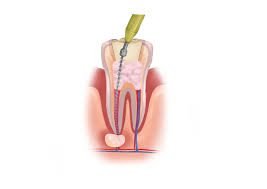Last Updated on March 12, 2024 by admin
During your last dental visit, your dentist recommended that you undergo root canal treatment. You must have trembled at the sound of it but it is not as scary as you think.
Table of Contents
What is root canal treatment?
When your tooth is damaged and the pulp inside is exposed, your dentist may advise you to have a root canal treatment. This is sometimes referred to as endodontic therapy which is of Greek origin – “endo” meaning inside and “odont” meaning tooth.
Essentially, root canal treatment means treating an infection inside the tooth. In most cases, your endodontist removes the infected pulp and covers the tooth surface. This way your teeth can be protected from future infections.
So, how should you go about a root canal treatment?
The 4 Stages of Root Canal Treatment
Diagnosis
The first stage of root canal treatment is diagnosing the infected pulp. Many people tend to ignore what they call “minor “ damages to the teeth like cracked, chipped, broken or pitted teeth. And let’s face it, sometimes you only visit the dentist because of a toothache.
During your dental check-up, your dentist will examine the source of your toothache. If he or she believes that your pulp is infected, your dentist will refer you for dental x-rays.
Tooth Imaging and X-rays
In most instances, your dentist will advise you to have one or two dental x-rays or digital tooth imaging. This can help determine the extent of infection or inflammation in your tooth pulp.
Preparing for the Treatment
After evaluating your tooth and root canal treatment is proper, your endodontist will administer local anaesthesia to numb the infected tooth and the tissues around it. When the sedatives have taken effect, a protective covering known as the “dental dam” will be placed to isolate the infected tooth while keeping it clean and saliva-free.
Removing the Infected Pulp
Now that your tooth is ready for treatment, your endodontist will proceed to eliminate the source of your toothache which is the infected root canal.
Extirpation
Once the tooth is isolated and ready for treatment, your endodontist will drill a hole for easier access to the root canal. He or she will clean the pulp chamber of infected pulp and apply an antiseptic or antibiotics to eliminate the bacteria and disinfect the tooth.
Instrumentation
After eliminating the infection, your tooth will need a thorough cleaning known as instrumentation. Your endodontist will check for infection deep within the root tip of your tooth and clean it using varying sizes of dental files.
In some cases, your endodontics may require you to have another x-ray to ensure that no infected pulp exists. He or she will use sodium hypochlorite to eliminate the remaining bacteria in the entire pulp chamber.
Root Canal Filling
When your tooth is clean and ready, your endodontist will now seal the tooth. This is to ensure that the pulp is protected and free from future infections.
Obturation
This step involves installing a rubber-like material to fill the root canals, referred to as gutta percha. The length of the material should cover until the deep ends of the pulp tip. It seals of the root canal to keep the bacteria away.
Once the gutta percha is placed, your endodontist will heat the material and compress it making sure it fits and seals the pulp chamber. A temporary filling is then placed to seal the tooth.
Tooth Restoration
You will then have to return to the dentist after a week or two. At this time the temporary filling is removed. Depending on the damage caused on the tooth, a permanent filling or a tooth crown will replace the temporary filling.
A restorative dentist will make sure that your tooth is protected and stronger with the permanent filling or dental crown. He or she aims to ensure that your tooth remains healthy and infection-free in the future.
What can you expect after a root canal treatment?
Many patients experience tooth sensitivity during the first couple of weeks following the treatment. In some rare cases, the tooth may swell as the tooth is adjusting to it’s new crown or filling. When this happens, be sure to visit your endodontist for proper medication.
Some patients may also experience an odd feeling when they bite. In which case, it may be best to book an appointment with your restorative dentist, so he or she can remedy the uneveness of the tooth filling or crown fitting.
While treating your infected root canal is as easy as these 4 stages, it helps to keeps your teeth clean and healthy at all times. Remember that prevention is always better than cure.
So, keep those pearly whites sparkling clean all the time by brushing your teeth at least twice a day. And always remember to visit your dentist at least twice a year to ensure oral health and hygeine.
Contact Smile Ville to learn more!
Read More: What You Need to Know About Root Canal Procedures

























